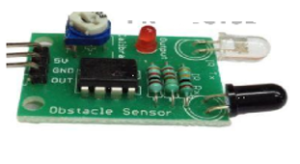In 1800 William Herchel, an astronomer accidentally discovered Infrared radiation. He was measuring the temperature of various colour of light after separation by prism. Suddenly he found that the temperature just beyond the red light was highest. Its wavelength is higher than visible light, so this electromagnet wave always invisible by open eyes. Everything with temperature higher then 5Kelvin produce Infrared radiation. And an IR (Infrared) Sensor is a device that detect and measure Infrared radiation.
We already discussed on PASSIVE INFRARED SENSOR or PIR Sensor. Now we will discuss on Active Inferred sensor……
Active Infrared Sensor consist of a 1) LED for emitting IR radiation and a 2) IR receiver for collecting reflected IR radiation. Active IR sensors commonly used in obstacle detection systems. When a substance come closer to the sensor, emitted IR radiation from LED reflected back by the substance and received by the receiver. It turns the output signal of the sensor module High or Low as per our requirement.
IR or infra-red sensor:

IR or infra-red sensor is an electronic component through which we can detect infra-red or infrared rays. IR sensor consists of two parts- 1) IR LED and 2) Photo-diode.
Both together are called photo-coupler or opto-coupler.

Aplication
One of the most common applications of IR sensor modules is in remote controls. When you press a button on your remote, the IR LED emits a specific pattern of infrared rays that are then detected by the sensor in the receiving device, such as a TV or air conditioner. This allows for wireless communication and control.
Another popular use of IR sensor modules is in proximity and obstacle detection systems. By emitting infrared radiation and measuring the reflected rays, these modules can determine the presence or absence of objects in their range. This functionality is employed in automatic door systems, where the sensor detects the presence of a person or object and triggers the opening or closing of the door.
IR sensor modules also find applications in line-following robots and automated industrial systems. By utilizing the reflected infrared rays, these modules can detect lines or markers on the ground and provide feedback for the robot or system to navigate or perform specific tasks accurately.
Moreover, IR sensor modules are used in security systems for motion detection. When an object or person moves within the sensor’s field of view, the infrared radiation pattern changes, triggering an alert or activating a surveillance camera.
In summary, IR or infrared sensor modules play a crucial role in various electronic devices and systems. With their ability to detect and measure infrared rays, they enable remote control functionality, proximity detection, line following, and motion sensing applications. These modules continue to contribute to advancements in technology, enhancing automation, convenience, and security in our daily lives.
